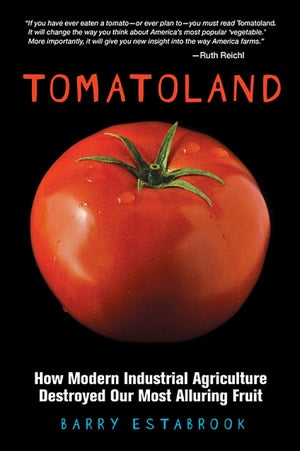Uncategorized
“Tomatoland” Book Review
Barry Estabrook, Tomatoland: How Modern Industrial Agriculture Destroyed Our Most Alluring Fruit (Kansas City: Andrews McMeel Publishing, LLC, 2011, 2012)

Food writer Barry Estabrook began his research with a simple question: Why do so many tomatoes lack taste and nutrition? Some $5 billion worth of “perfectly round, perfectly red, and, in the opinion of many consumers, perfectly tasteless” tomatoes found their way into Americans’ sandwiches, salads and other dishes in 2009. Why “can’t we walk into a supermarket in December and buy the tomato of our dreams?” he asks.
The answer, he learns, lies in the world of corporate agriculture in Florida. The Florida Tomato Committee, an influential trade group, regulates the size and shape of the tomatoes produced in that state. While Estabrook attends at length to the genetics, breeding and history of tomatoes, a central thrust of his book centers on industrial and labor relations in the agribusiness sector. The picture he paints can only be described as disturbing and depressing.
Florida, as Estabrook shows, is hardly a natural place to grow tomatoes, with sandy soil without nutrients, unpredictable and damaging weather, and an overabundance of fungal diseases and threatening insects. To make matters worse, Mexican competition exerts heavy pressure on profit margins.
Growers also protect profit margins by squeezing their work force, composed largely of Hispanic migrants. The hiring and management of labor has long been subcontracted to crew bosses, allowing corporate farmers “to avoid direct responsibility for day-to-day abuses.”
Those abuses, Estabrook shows, can be horrific. Crew bosses often house their migrant workers in substandard and even subhuman facilities. “Day in and day out,” farmworkers enter “poisoned fields and expose themselves to a witch’s brew of toxic chemicals.” And the subcontracting system has resurrected a particular heinous form of labor—slavery—in which migrants are beaten, imprisoned and essentially enslaved, forcibly prevented from fleeing through sheer violence. Wage rates for up to 12 hours of backbreaking labor allow migrant fieldworkers to bring home less than $12,000 a year.
Given this state of affairs, it’s not hard to guess that migrant farm workers constitute a nonunion labor force. The landmark National Labor Relations Act of 1935, which affirmed workers’ right to organize and afforded legal protections of that right, specifically exempted agricultural workers from its coverage (a condition of its passage imposed by Southern congressmen invested in cheap farm labor and the Jim Crow racial system).
Answering his question about why contemporary tomatoes lack taste required Estabrook to enter the world of industrial agriculture, where he discovered the “tremendous human cost” of tomato production. A moving, unsettling and, at times, uplifting book, “Tomatoland” is a highly engaging, fast-paced and informative exposé in the best muckraking journalistic tradition.
By Eric Arnesen, who teaches labor history at The George Washington University and serves as a member of the Teamsters Labor History Research Center Advisory Board. For the complete review, visit www.teamster.org.